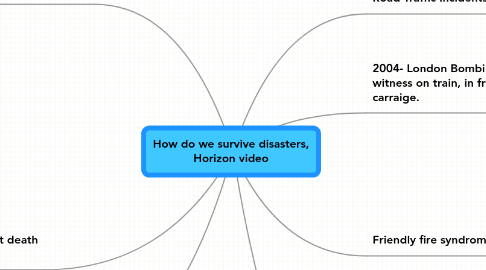How do we survive disasters, Horizon video
저자: Helen Bedford

1. How do we survive?
1.1. 'need to be able to do things right first time'. Preparation is key!
1.2. Oil rig workers are taught helicopter drills, it is key that we learn when we are not under stress, so that when we are, we can just do.
1.3. on a boat for example you can work out where life boats are in preparation.
1.4. On a plane you can read the safety and evacuation procedures, and learn how you would get out if there was an incident.
1.5. Fire drills are agood example of this sort of preperation. Rick Rescorla, the head of security for Morgan Stanley in the twin towers made the staff practice fire drills regularly. On the September 11th 2001, virtually everyone from Morgan Stanley escaped the building alive, as they knew where to go and how to get out, unlike a lot of the other staff. Out of 3000 employees only 13 were killed, including Roscorola himself, in his efforts to save lives.
1.6. It is not just luck, every second matters!
1.7. In America, if you stay in a hotel, in a room on the floors below 6th, fire ladders can reach here. Should always look for escape routes. Examples of being prepared include carrying a smoke hood at all times and counting the doors to from your door to the nearest fire exit, incase an incident occurs in the dark.
1.8. Need to make rational logical judgements, without emotional reaction. We often dont judge things as, as dangerous as they really are, eg. Dog is scarier than toaster? It is threats that happen less often eg. plain crashes and terrorist attacks that we are most scared of, when really we should be concerned about more likely dangers.
2. Government death statistics
2.1. Per year 300 people die from fire related injuries.
2.2. Per year 200 people die from drowning.
2.3. Tests done in the Health and Safety lab reveal that a suprising amount of deaths per year, are caused by slipping. 40% of falls from height are caused by slipping.
3. Eye witness account, sinking estonian ship
3.1. Paul Barney slept in the Cafeteria of the ship the night it sank. The ship rolled and Barney became trapped, he managed to clamber out on the pipework along the ceiling of the ship, out on to the hull and onto a life raft. Barney describes how changes occured in his mind, he experienced tunnel vision and was purely thinking about what was going to save him. Barney cannot remember sound, only the wind, his tunnel vision blocked it out.
4. 2004- London Bombings, Eye witness on train, in front carraige.
4.1. 26 people died on that train, the bomber detinated the bomb 4 metres away from Susan, she tried to get up but her leg was seriosly injured, she had a broken leg, it was bleeding and the skin had been peeled off by the blast. Susan used her belt as a touniquet, which saved her life as it took 30 minutes for paramedics to reach her. Susan believes that she survived due to a high level of self confidence and a good ability to cope with stress, she also believed that she was going to make it.
5. Friendly fire syndrome
5.1. One of the biggest killers is failing to react, eg. Bradford football club.
5.2. In the Woolworths fire Manchester people thought they had longer to get out than they acctually did, people even stayed in the smoke filled cafeteria, just to finish their food, this is an example of friendly fire syndrome.
5.3. 9/11, people took too long to react, and did not evacuate immediately. The biggest delay was caused by people trying to work out what had happened and what to do, it did not help that alot of people thought the alarms were just a drill. Another huge factor was peer pressure, people thought 'someone is surely going to say something soon'.
5.4. New York, late 1960's experiment. Participants were led to a waiting room, and smoke was released under the door. The researchers watched how long it took the participants to leave. When the participants were on their own in the room 75% of people left. When there was a group in the room only 10% left. This is thought to be due partly to peer pressure and partly to the fact that the participants cound not see the fire and so did not think they were in immediate danger.
5.5. Frinedly fire syndrome is thought to be caused by the fact that modern people do not deal with fire anymore and so do not realise its properties and strengths.
6. Road Traffic Incidents
6.1. As the vehicle slows the persons body keeps moving.
6.2. 1000's of crash tests are undertaken every year.
6.3. Dummies are used to test the force put on the body during a test. Once a researcher used his own body.
7. Flight 232 from Denver- eye witness account
7.1. Engine failure severed hydraulic lines, the plain lost control. The captain told the passengers it was going to 'be a rough landing', the captain attepted an emergency landing. The eyewitness only heard the noise of metal, and can only remember complete darkness. The first thing she heard was, 'you cant go out there, theres fire'. The eyewitness underwent a perceptual change, which is experienced by many, this was time distortion. She remembers that it 'went on forever, seemed like it didnt stop'. This distortion is caused by the brain taking in more information, and operating more effectively, this is very helpful. With this particular her stress threshold was met and she experienced the inability to focus and cope, and was 'rooted to the spot'.


